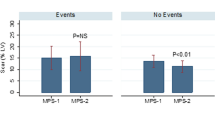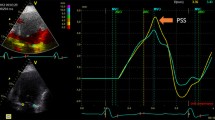Abstract
Higher angiographic perfusion score (APS) following percutaneous coronary intervention (PCI) for ST-segment elevation myocardial infarction (STEMI) has been shown to be associated with improved clinical outcomes. The association between APS after STEMI and left ventricular remodeling as assessed by volumetric parameters derived from left ventriculography has not been assessed. Methods The APS (the arithmetic sum of the TIMI Flow Grade (TFG) and TIMI Myocardial Perfusion grade (TMPG) before and after percutaneous coronary intervention (PCI), range of 0–12) was assessed in 168 patients from the GRACIA-2 trial. Left ventriculograms performed in the 30° right anterior oblique projection were obtained among 148 patients at initial angiography (prior to PCI) and at 6 weeks. The association of APS with markers of left ventricular remodeling at 6-weeks was examined using left ventricular ejection fraction, delta end systolic volume, delta stroke volume and wall motion index. Results Full perfusion (APS 10–12), as compared to partial perfusion (APS 4–9) or failed perfusion (APS 0–3), was associated with a greater left ventricular ejection fraction (61.6% ± 10.0 vs. 56.9% ± 12.5 vs. 49.8% ± 16.9, P = 0.015), a decrease in left ventricular end systolic volume indicating favorable remodeling (mean −4.1 cc ± 17.3 vs. +2.0 cc ± 17.3 vs. +9.8 cc ± 16.1, P = 0.015), a greater improvement in left ventricular stroke volume (mean +13.7 cc ± 17.1 vs. +6.7 cc ± 15.5 vs. +1.2 cc ± 13.4, P = 0.009) and a decreased wall motion index (number of chords in the hypokinetic region) (mean 15.1 ± 16.4 vs. 21.4 ± 20.5 vs. 32.9 ± 22.1, P = 0.026) at 6 weeks. Conclusion In conclusion, among patients treated with combined reperfusion and revascularization strategies for STEMI, higher APS is associated with more favorable markers of left ventricular remodeling and improved 6-week left ventricular function.




Similar content being viewed by others
Abbreviations
- APS:
-
Angiographic perfusion score
- PCI:
-
Percutaneous coronary intervention
- STEMI:
-
ST-elevation myocardial infarction
- TFG:
-
TIMI flow grade
- TIMI:
-
Thrombolysis in myocardial infarction
- TMPG:
-
TIMI myocardial perfusion grade
References
Angeja BG, Gunda M, Murphy SA et al (2002) TIMI myocardial perfusion grade and ST segment resolution: association with infarct size as assessed by single photon emission computed tomography imaging. Circulation 105(3):282–285
Schomig A, Ndrepepa G, Kastrati A (2006) Late myocardial salvage: time to recognize its reality in the reperfusion therapy of acute myocardial infarction. Eur Heart J 27(16):1900–1907
Balachandran KP, Berry C, Norrie J et al (2004) Relation between coronary pressure derived collateral flow, myocardial perfusion grade, and outcome in left ventricular function after rescue percutaneous coronary intervention. Heart 90(12):1450–1454
Hoffmann R, Haager P, Arning J et al (2003) Usefulness of myocardial blush grade early and late after primary coronary angioplasty for acute myocardial infarction in predicting left ventricular function. Am J Cardiol 92(9):1015–1019
Bellandi F, Leoncini M, Maioli M, Toso A, Gallopin M, Piero Dabizzi R (2004) Markers of myocardial reperfusion as predictors of left ventricular function recovery in acute myocardial infarction treated with primary angioplasty. Clin Cardiol 27(12):683–688
Araszkiewicz A, Lesiak M, Grajek S et al (2007) Effect of microvascular reperfusion on prognosis and left ventricular function in anterior wall myocardial infarction treated with primary angioplasty. Int J Cardiol 114(2):183–187
Bax M, de Winter RJ, Schotborgh CE et al (2004) Short- and long-term recovery of left ventricular function predicted at the time of primary percutaneous coronary intervention in anterior myocardial infarction. J Am Coll Cardiol 43(4):534–541
Bolognese L, Carrabba N, Parodi G et al (2004) Impact of microvascular dysfunction on left ventricular remodeling and long-term clinical outcome after primary coronary angioplasty for acute myocardial infarction. Circulation 109(9):1121–1126
Ito H, Maruyama A, Iwakura K et al (1996) Clinical implications of the ‘no reflow’ phenomenon. A predictor of complications and left ventricular remodeling in reperfused anterior wall myocardial infarction. Circulation 93(2):223–228
Galiuto L, Gabrielli FA, Lombardo A et al (2007) Reversible microvascular dysfunction coupled with persistent myocardial dysfunction: implications for post-infarct left ventricular remodelling. Heart 93(5):565–571
Gibson CM, Murphy SA, Morrow DA et al (2004) Angiographic perfusion score: an angiographic variable that integrates both epicardial and tissue level perfusion before and after facilitated percutaneous coronary intervention in acute myocardial infarction. Am Heart J 148(2):336–340
Pride YB, Buros JL, Lord E et al (2007) Angiographic perfusion score in patients treated with PCI at late angiography following fibrinolytic administration for ST-segment elevation myocardial infarction is associated with morbidity and mortality at 30 days. J Thromb Thrombolysis [Epub ahead of print]
Fernandez-Aviles F, Alonso JJ, Pena G et al (2007) Primary angioplasty vs. early routine post-fibrinolysis angioplasty for acute myocardial infarction with ST-segment elevation: the GRACIA-2 non-inferiority, randomized, controlled trial. Eur Heart J 28(8):949–960
Antman EM, Anbe DT, Armstrong PW et al (2004) ACC/AHA guidelines for the management of patients with ST-elevation myocardial infarction: a report of the American College of Cardiology/American Heart Association Task Force on Practice Guidelines (Committee to Revise the 1999 Guidelines for the Management of Patients with Acute Myocardial Infarction). Circulation 110(9):e82–e292
Van de Werf F, Ardissino D, Betriu A et al (2003) Management of acute myocardial infarction in patients presenting with ST-segment elevation. The Task Force on the Management of Acute Myocardial Infarction of the European Society of Cardiology. Eur Heart J 24(1):28
TIMI Study Group (1985) The Thrombolysis in Myocardial Infarction (TIMI) trial. Phase I findings. TIMI Study Group. N Engl J Med 312(14):932–936
Gibson CM, Schomig A (2004) Coronary and myocardial angiography: angiographic assessment of both epicardial and myocardial perfusion. Circulation 109(25):3096–3105
Balachandran KP, Berry C, Pell AC, Vance BD, Oldroyd KG (2006) Improvement in left ventricular function following successful rescue percutaneous coronary intervention is independent of time-to-reperfusion. J Invasive Cardiol 18(7):330–333
Gibson CM, Cannon CP, Murphy SA, Marble SJ, Barron HV, Braunwald E (2002) Relationship of the TIMI myocardial perfusion grades, flow grades, frame count, and percutaneous coronary intervention to long-term outcomes after thrombolytic administration in acute myocardial infarction. Circulation 105(16):1909–1913
Author information
Authors and Affiliations
Consortia
Corresponding author
Additional information
The GRACIA-2 trial was funded by unrestricted grants from the La Red Temática de Enfermedades Cardiovasculares (RECAVA) from the Instituto de Salud Carlos III of the Spanish Ministry of Health, the Spanish Society of Cardiology, Guidant CO, and Lilly CO. Additional support was obtained from Guidant CO to reimburse interventional centers for the cost of stents. No additional funding was received for the present analysis.
Rights and permissions
About this article
Cite this article
Abraham, J.M., Gibson, C.M., Pena, G. et al. Association of angiographic perfusion score following percutaneous coronary intervention for ST-elevation myocardial infarction with left ventricular remodeling at 6 weeks in GRACIA-2. J Thromb Thrombolysis 27, 253–258 (2009). https://doi.org/10.1007/s11239-008-0206-1
Received:
Accepted:
Published:
Issue Date:
DOI: https://doi.org/10.1007/s11239-008-0206-1




